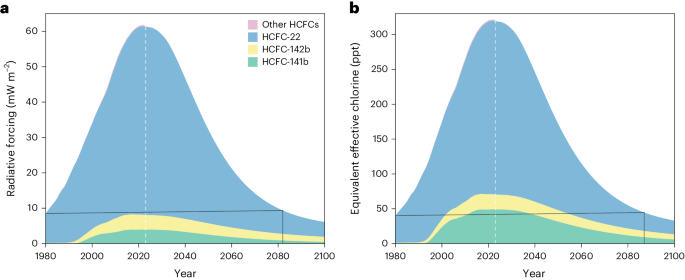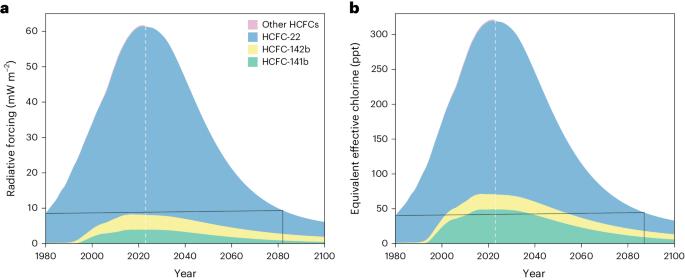A decrease in radiative forcing and equivalent effective chlorine from hydrochlorofluorocarbons
IF 29.6
1区 地球科学
Q1 ENVIRONMENTAL SCIENCES
引用次数: 0
Abstract
The Montreal Protocol and its successive amendments have been successful in curbing emissions of ozone-depleting substances and potent greenhouse gases via production/consumption controls. Here we show that the radiative forcing and equivalent effective chlorine from hydrochlorofluorocarbons has decreased from 61.75 mW m−2 and 321.69 ppt, respectively, since 2021, 5 years before the most recent projected decrease. This important milestone demonstrates the benefits of the Protocol for mitigating climate change and stratospheric ozone layer loss. Hydrochlorofluorocarbons are important ozone-depleting substances. Here the authors show that the radiative forcing and equivalent effective chlorine from hydrochlorofluorocarbons has decreased in recent years, 5 years earlier than expected.


氟氯烃产生的辐射强迫和等效有效氯的减少
蒙特利尔议定书》及其历次修正案成功地通过生产/消费控制遏制了臭氧消耗物质和强效温室气体的排放。我们在此表明,自 2021 年以来,氯氟烃的辐射强迫和等效有效氯已分别从 61.75 mW m-2 和 321.69 ppt 下降,比最新预测的降幅早了 5 年。这一重要的里程碑显示了《议定书》在减缓气候变化和平流层臭氧层丧失方面的惠益。
本文章由计算机程序翻译,如有差异,请以英文原文为准。
求助全文
约1分钟内获得全文
求助全文
来源期刊

Nature Climate Change
ENVIRONMENTAL SCIENCES-METEOROLOGY & ATMOSPHERIC SCIENCES
CiteScore
40.30
自引率
1.60%
发文量
267
审稿时长
4-8 weeks
期刊介绍:
Nature Climate Change is dedicated to addressing the scientific challenge of understanding Earth's changing climate and its societal implications. As a monthly journal, it publishes significant and cutting-edge research on the nature, causes, and impacts of global climate change, as well as its implications for the economy, policy, and the world at large.
The journal publishes original research spanning the natural and social sciences, synthesizing interdisciplinary research to provide a comprehensive understanding of climate change. It upholds the high standards set by all Nature-branded journals, ensuring top-tier original research through a fair and rigorous review process, broad readership access, high standards of copy editing and production, rapid publication, and independence from academic societies and other vested interests.
Nature Climate Change serves as a platform for discussion among experts, publishing opinion, analysis, and review articles. It also features Research Highlights to highlight important developments in the field and original reporting from renowned science journalists in the form of feature articles.
Topics covered in the journal include adaptation, atmospheric science, ecology, economics, energy, impacts and vulnerability, mitigation, oceanography, policy, sociology, and sustainability, among others.
 求助内容:
求助内容: 应助结果提醒方式:
应助结果提醒方式:


